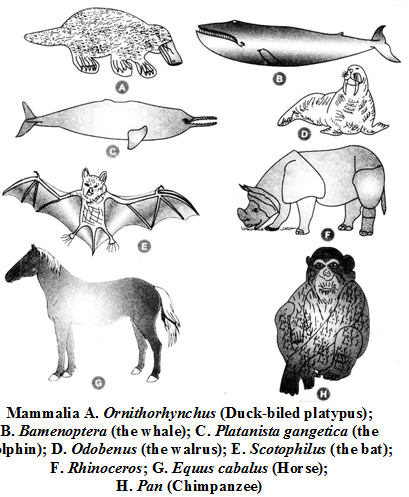Chapter : 4. Diversity In Living Organism
Class - Mammalia
Class - Mammalia :
Mammals are primarily terrestrial vertebrates. They occur in all sorts of habitats from the polar regions to the tropics.
The body is variously shaped and generally divisble into head, neck, trunk and tail.
The skin is glandular and mostly covered by a horny epidermal exoskeleton of hair.
There are two pairs of pentadactyl limbs. These are variously adapted for various purposes.
Respiration occurs only by lungs.
The heart is four chambered, having two auricles and two ventricles.
Sexs are usually distinguishable externally.
Mammals are mostly viviparous (alive-bearing). However, some are oviparous and lay eggs (e.g., platypus and echidna. Kangaroos give brith to very poorly developed young ones). They are characterized by having milk-secreting mammary glands in the females for sucking the young for some time after birth.
Examples : Macropus (Kangaroo), Bat, Ratuus (rat), Oryctolagus (rabit), Felis (cat), Panthera (lion, tiger, leopard), Canis (dog) Elephas (elephant), Balaena (whale), Macaca (monkey), Hamo (man), Pan (chimpanzee)

Trending Articles & Blogs
- Physics Tutor, Math Tutor Improve Your Child’s Knowledge
- How to Get Maximum Marks in Examination Preparation Strategy by Dr. Mukesh Shrimali
- 5 Important Tips To Personal Development Apply In Your Daily Life
- Breaking the Barriers Between High School and Higher Education
- 14 Vocational courses after class 12th
- Tips to Get Maximum Marks in Physics Examination
- Get Full Marks in Biology Class 12 CBSE
Download Old Sample Papers For Class X & XII
Download Practical Solutions of Chemistry and Physics for Class 12 with Solutions
Recent Questions Asked
- Newton’s laws of motion asked by Dr. Mukesh Shrimali
- Process of nutrition in Amoeba asked by Rajiv Sharma
- Importance of studying physics subject in school after 10th asked by Rajiv
- Refraction Through Prism in Different Medium asked by Kirti Sharma
- Ratio and Proportion Question asked by Education Desk
- Explain all the 12 tenses with example asked by Qwerty
- Refraction Through Prism in Different Medium asked by Seema Shrimali